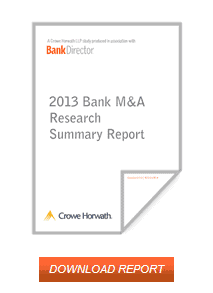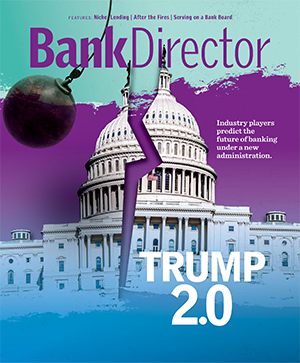
The Price Is Not Right

According to the survey, which was completed by 224 bankers in October, 57 percent of respondents hope to make some form of acquisition this year, which is up from 52 percent last year. Of those, 46 percent want to buy a healthy bank, 21 percent are interested in branches, and 17 percent seek to buy an FDIC assisted institution. Last year, there was less interest in healthy banks at 37 percent but more interest in branches and FDIC assisted transactions—at 27 percent and 24 percent, respectively.
Respondents looking at acquisitions outside of their core branch banking franchise show particular interest in investment management and/or trust businesses at 40 percent and insurance brokerage and/or agency businesses at 30 percent. Twenty-nine percent of those looking at acquisitions outside of their core banking franchise seek to acquire a residential mortgage origination business.
Chad Kellar, senior manager at Crowe Horwath LLP, explains that acquisitions of mortgage origination businesses are of interest right now given the relatively strong position of mortgage companies that made it through the worst of the financial crisis.
“Sales are very strong right now, and obviously the refinancing boom is continuing,” says Kellar. “So those [mortgage companies] specializing in refinance, in particular, are going gangbusters this year and last year relative to what they had been doing even before the downturn.”
For potential buyers, the top three reasons for making an acquisition did not change this year, with 63 percent of respondents wanting to supplement organic growth, 60 percent looking to increase market share and 41 percent trying to rationalize the cost of regulation over a wider base.
Not surprisingly, pricing is the number-one barrier for both buyers and sellers. Sixty-two percent of buyers cite unrealistically high pricing expectations as a top barrier to an acquisition, and 71 percent of potential sellers feel the pricing is too low to make a deal.
The disagreements over pricing may come down to perceived asset quality—with 59 percent of buyers concerned about the asset quality of potential targets but only 5 percent of sellers reporting subpar asset quality as a barrier to selling their bank.
“From the perspective of an acquirer, there is still significant concern about what the seller is reporting as their asset quality,” says Kellar. “Through a number of transactions where we go in and say, “here’s the potential loss,” it’s still a multiple of what the seller’s board is thinking. So there is a pretty big divide between an acquirer that’s healthy enough to go do a transaction and the seller in a lot of these situations.”
Until these pricing issues are resolved, it appears that any great wave of M&A activity will have to be put on hold. Eighty-nine percent of respondents say they have no intention of selling a bank, branch, line of business, or loan portfolio in the next year. Only 2 percent of respondents report they are planning to sell a bank, which could be bad news for the 46 percent who say they want to buy one.
Rick Childs, director at Crowe, says these results are consistent with what he has been seeing in practice.
“While waves of consolidation have been predicted for a number of years, the survey really indicates that credit quality and pricing concerns have really held back the level of consolidation,” says Childs. “I think banks aren’t as interested in selling as the predictions would suggest. Certainly, increased regulation creates headwinds and the survey shows that banking is not as fun [as it used to be]. But I think these people are still committed to independence, not wanting to have the hometown bank owned by somebody else. There’s still a lot of pride in that.”
For the full summary report, click here.
**A full discussion of survey results will appear in the 1st Quarter 2013 Issue of Bank Director magazine.

